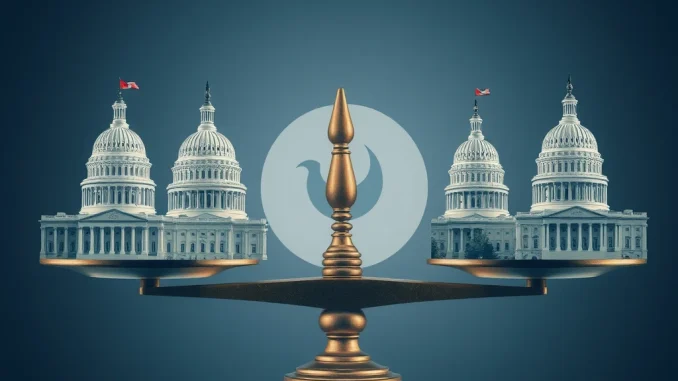
The ever-evolving landscape of cryptocurrency regulation in the United States is once again under the spotlight, and this time, stablecoins are taking center stage. In a significant move, Ivan Soto-Wright, the CEO of prominent crypto payments firm MoonPay, has stepped into the fray, urging U.S. lawmakers to consider the critical role of state oversight in upcoming stablecoin legislation. Why is this plea so important, and what could it mean for the future of crypto innovation? Let’s dive deep into this developing story.
Why State Oversight is ‘Crucial’ for Stablecoin Regulation?
Soto-Wright’s appeal, articulated in a letter addressed to key figures in the U.S. Senate Banking and House Financial Services Committees, directly supports amendments proposed by the Conference of State Bank Supervisors (CSBS). But what exactly is the CSBS advocating for, and why does MoonPay’s CEO believe in their approach to stablecoin regulation?
The core argument revolves around preserving the existing state regulatory frameworks that have been instrumental in fostering innovation within the financial technology sector. Here’s a breakdown of the key reasons why maintaining state oversight is considered vital:
- Fostering Innovation: State regulatory bodies are often perceived as more agile and adaptable to the rapidly changing nature of the crypto industry. They can provide a more streamlined and less bureaucratic pathway for new projects and stablecoin issuers to emerge and thrive.
- Tailored Regulation: State-level regulators are closer to their local markets and can tailor regulations to better suit the specific needs and characteristics of their jurisdictions. This nuanced approach can be more effective than a one-size-fits-all federal framework.
- Preventing Regulatory Overreach: Concerns exist that overly centralized federal regulation could stifle innovation and create barriers to entry for smaller players in the crypto space. A balanced federal-state approach could mitigate this risk.
- Building on Existing Frameworks: States already have established regulatory structures for money transmission and other financial services. Leveraging these existing frameworks for stablecoin regulation can be more efficient and less disruptive than creating entirely new federal systems from scratch.
Soto-Wright’s letter emphasizes the need to avoid inadvertently undermining these state pathways. He argues that a purely federal approach could inadvertently create an uneven playing field, potentially favoring larger, more established institutions at the expense of smaller, innovative startups. This is a sentiment echoed by many in the crypto industry who fear that overly stringent federal rules could stifle the very innovation that has made the crypto space so dynamic.
Decoding the STABLE and GENIUS Acts: What’s at Stake for Crypto Legislation?
The context of Soto-Wright’s letter is crucial. He specifically references the STABLE Act and the GENIUS Act, two proposed pieces of crypto legislation that are currently being debated in Congress. Understanding these acts is key to grasping the significance of the current regulatory discussions.
While details of these acts can evolve, generally:
- The STABLE Act (Stablecoin Transparency of Reserves and Uniform Law Enforcement Act): This act has been proposed to regulate stablecoin issuers more like banks, requiring them to obtain banking charters and adhere to federal banking regulations. Concerns have been raised that this approach could be overly restrictive and hinder the growth of the stablecoin market.
- The GENIUS Act (Guiding Encryption and National Initiatives for Ubiquitous Standards Act): While potentially broader in scope, it also touches upon digital assets and could impact the regulatory landscape for cryptocurrencies, including stablecoins.
The amendments proposed by the CSBS, and supported by MoonPay’s CEO, are likely aimed at ensuring that these acts, or any final crypto legislation, incorporate provisions for continued state oversight. The goal is to create a regulatory framework that is both robust and conducive to innovation, striking a balance between federal and state roles.
MoonPay CEO’s Stand: A Boost for Decentralized Crypto Future?
MoonPay’s public stance on this issue is noteworthy. As a leading crypto payments infrastructure company, MoonPay’s business model is deeply intertwined with the growth and adoption of cryptocurrencies, including stablecoins. Their support for state oversight can be interpreted as a move to advocate for a more decentralized and accessible crypto ecosystem.
Here’s why MoonPay’s advocacy matters:
- Industry Influence: MoonPay is a significant player in the crypto space. Their voice carries weight and can influence policymakers’ perspectives on regulatory matters.
- Protecting Business Interests: While advocating for broader industry principles, MoonPay’s stance also aligns with their business interests. A more innovation-friendly regulatory environment benefits companies like MoonPay that rely on the dynamism of the crypto market.
- Supporting a Balanced Approach: By supporting the CSBS amendments, MoonPay is signaling its preference for a balanced regulatory approach that avoids stifling innovation while ensuring consumer protection and market integrity.
The involvement of MoonPay CEO Ivan Soto-Wright in this regulatory debate underscores the high stakes for the crypto industry. His direct appeal to lawmakers highlights the industry’s proactive engagement in shaping the future of stablecoin regulation in the U.S.
The Road Ahead: Navigating the Complexities of Crypto Legislation
The debate surrounding stablecoin regulation is far from over. As Congress continues to grapple with these complex issues, the input from industry leaders like Ivan Soto-Wright and organizations like the CSBS will be crucial. The ultimate outcome will likely shape the trajectory of the crypto industry in the U.S. for years to come.
Here are some key takeaways to consider as this regulatory landscape evolves:
- Continued Dialogue is Essential: Open communication and collaboration between regulators, industry players, and policymakers are vital to creating effective and balanced regulations.
- Innovation vs. Regulation: Finding the right balance between fostering innovation and ensuring consumer protection is the central challenge. Regulations should be designed to mitigate risks without stifling growth.
- Global Implications: The U.S.’s approach to crypto legislation will have global implications, potentially influencing regulatory frameworks in other jurisdictions.
- Stay Informed: Keeping abreast of developments in crypto legislation is crucial for anyone involved in or interested in the crypto space.
In conclusion, MoonPay CEO Ivan Soto-Wright’s intervention in the stablecoin regulation debate is a significant development. His call for preserving state oversight reflects a broader industry desire for a regulatory framework that encourages innovation while ensuring responsible growth. The coming months will be critical in determining the final shape of crypto legislation and its impact on the future of digital assets in the United States.



